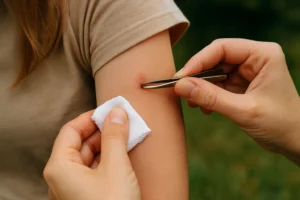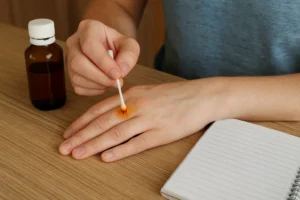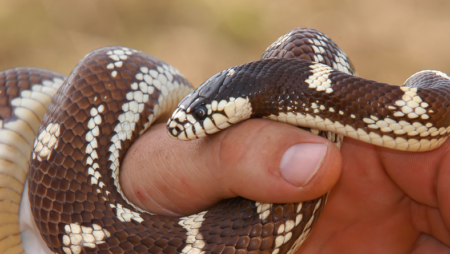
How to remove a tick by yourself is a question where mistakes can be costly. The longer a tick stays embedded in the skin, the higher the risk of transmitting infections (borreliosis/Lyme disease, tick-borne encephalitis). The key is quick, careful and correct removal with minimal skin trauma and without squeezing the parasite’s body.
Why speed and technique matter
A tick inserts a barbed proboscis into the skin and injects saliva with an anaesthetic, so the bite often goes unnoticed. Wrong actions (squeezing, tearing, “suffocating” with oil) increase salivation and may raise the risk of infection. Safe removal means a controlled grip as close to the skin as possible and a steady motion without sharp tugs.
Myths and mistakes to avoid
- Do not douse with oil, alcohol, nail varnish or petrol. A “suffocated” tick releases more saliva/intestine contents.
- Do not cauterise or heat. Heat provokes regurgitation of the tick’s contents into the wound.
- Do not crush or twist by the body. Squeezing the abdomen increases the risk of transmitting pathogens.
- Do not apply aggressive antiseptics to the wound (concentrated alcohol, brilliant green) before removal — first take the tick out, then treat the skin.
What to prepare before removal
- Fine-tipped straight tweezers or a dedicated tick extractor (card, hook, lasso).
- Gloves or clean hands washed with soap.
- Skin antiseptic (aqueous chlorhexidine/povidone-iodine or another gentle skin antiseptic).
- Clean gauze/plaster to cover the bite after treatment.
- A small container/zip-lock bag and a date sticker — if you need to keep the tick for further testing.
Brief safe-removal algorithm
- Calmly stabilise the skin and position the tweezers/extractor as close to the skin as possible — grip the proboscis, not the abdomen.
- Pull steadily upwards (perpendicular to the skin) without jerking; if using a hook/lasso, follow the tool’s instructions.
- Once the tick is out, treat the skin with an antiseptic, and cover with gauze/plaster if needed.
- Wash your hands with soap. Dispose of the tick or store it in a container labelled with the date/place of the bite.
When you must see a doctor
- A piece of the proboscis remains and there’s inflammation or purulent discharge.
- Migratory redness appears (a ring-shaped “target”), fever, weakness, muscle/joint pain.
- A bite on the face, genitals, near the eyes, or if the person affected is a child, pregnant, or immunocompromised.
In the next section you’ll find a detailed step-by-step guide for each tool (tweezers, hook, “lasso” extractor), plus wound care and symptom monitoring over 30 days.
How to remove a tick properly with tweezers, thread or a special hook

There are a few tried-and-tested ways to remove a tick yourself — the main thing is to avoid tearing the parasite’s body. All methods aim to extract the tick completely without squeezing the abdomen or leaving the proboscis in the skin. Below are three of the safest methods you can use at home.
🔹 Method No. 1: Fine-tipped tweezers
- Disinfect the tweezers and your hands.
- Grip the tick as close to the skin as possible, under the proboscis — not by the body.
- Gently pull straight upwards; do not twist or yank.
- Once the tick is out, treat the area with an antiseptic.
- Don’t crush the insect with bare hands — burn it or place it in a sealed container.
Tip: if you feel resistance, don’t jerk — make slight rocking movements side to side. Better to take a few extra seconds than damage the tick’s body.
🔹 Method No. 2: Hook or special “lasso” extractor
Modern pharmacy kits (Tick Twister, Tick Remover) allow you to detach a tick with a gentle twisting motion without squeezing the abdomen. Using a hook is simple:
- Slide the hook under the tick from the skin side.
- Rotate the tool around its axis (1–2 turns) and the tick will come out with the proboscis.
- Treat the wound with an antiseptic.
Advantage: a hook reduces the risk of tearing, so it’s suitable even for beginners.
🔹 Method No. 3: Thread loop
If you don’t have tweezers or a hook to hand, you can use a thread — this method requires maximum care:
- Make a loop from a strong thread (silk or nylon).
- Slip the loop over the tick right at skin level.
- Carefully tighten the loop to secure the parasite.
- Slowly pull upwards with gentle rotational movements (anti-clockwise).
Common mistakes when removing a tick:
- A sharp tug — the head or proboscis may remain;
- Squeezing the tick’s body — risk of injecting infection into the skin;
- Insufficient disinfection of tools or hands.
After successful removal, don’t panic — most bites do not lead to infection. The main thing is to watch your skin and how you feel over the next few weeks. In the next section: how to treat the wound properly, what to do with the tick, and which symptoms mean you should see a doctor.
What to do after removing a tick: disinfection, monitoring and infection prevention

Once you’ve gently removed the tick, the priority is proper care of the bite site and close monitoring of your condition. Even if the insect was tiny, don’t be complacent — symptoms of infection can appear after a few days or even weeks.
🧴 Treating the bite
- Rinse the skin with clean water and soap.
- Treat the bite with an antiseptic — chlorhexidine, povidone-iodine or miramistin work best.
- Cover with a sterile gauze or plaster for 1–2 hours.
- Do not scratch or irritate the skin at the bite site.
🧪 What to do with the tick
If possible, keep the tick for testing — it can help determine whether it carried dangerous pathogens.
- Place the insect in a sturdy container or a zip-lock bag.
- Add a small piece of damp cotton wool so the tick doesn’t dry out.
- Label it with the date and location of the bite.
- Contact your local public health centre or a private laboratory that performs PCR testing of ticks for borreliosis, encephalitis and other infections.
⏱️ Observation period
Even if the tick was removed completely, it’s important to watch for symptoms over the next 30 days. If any of the following appear, seek medical advice from an infectious-disease specialist or dermatologist immediately:
- Expanding ring-shaped redness (erythema);
- Fever, headache, muscle or joint pain;
- Weakness, lymphadenitis (enlarged lymph nodes), rash;
- Nausea, sleep disturbances, neck or lower-back pain.
💉 Preventing tick-borne encephalitis
If you live in or travel to a region with a high prevalence of infected ticks, consider vaccination against tick-borne encephalitis. It’s the most reliable protection, providing immunity for several years. The vaccine is given in two doses 1–3 months apart, followed by a booster after 3 years.
Tip:
- Do not self-medicate with antibiotics after a bite — this can mask the clinical picture.
- Avoid alcohol or aggressive products immediately after removal — they dry and irritate the skin.
Next, we’ll look at how to prevent tick bites in future: smart clothing choices, repellents, behaviour outdoors and checking your body after a walk.
How to avoid tick bites: prevention, protection and proven safety tips

Preventing tick bites is the best way to protect yourself and your loved ones from dangerous infections. To avoid unpleasant consequences, it’s important not only to use protective products but also to know where ticks are most commonly found and how to behave outdoors.
🌿 Where you’re most likely to encounter ticks
- Tall grass, path edges, forest clearings, shrubbery;
- Parks, squares, gardens, allotments — especially near bushes and in the shade;
- Areas with damp soil, leaf litter and moss where direct sun doesn’t reach.
Ticks don’t drop from trees, as many people think. They climb to 30–60 cm and wait for a host to brush past so they can latch onto clothing or fur.
🧢 Clothing to protect against ticks
- Wear light-coloured clothing with long sleeves — ticks are easier to spot on it;
- Tuck trousers into socks or boots, and shirts into trousers;
- Clothing should fit closely without being tight — so ticks can’t crawl underneath;
- Use a hat or hood, especially in the forest.
🧴 Repellents and acaricides
Repellents help repel ticks, while acaricides kill them. Choose products with proven active ingredients:
- DEET — effective against ticks and mosquitoes; apply to clothing and exposed skin;
- Icaridin (picaridin) — less irritating, suitable for children and sensitive skin;
- Permethrin — for treating clothing, remains effective after several washes.
Always read the instructions before use. Do not apply to irritated or broken skin.
🔍 Checking your body after a walk
After returning from nature, check your whole body carefully — ticks often latch on in hard-to-see places:
- Armpits, neck, behind the ears, groin, backs of the knees;
- Under belts, in clothing folds, under a bra;
- Check your hair separately, especially the nape.
It’s best to do the check with a partner or using a mirror. Aim to check within 2 hours of your outing — this significantly reduces the risk of infection.
🐾 If you’ve been out with pets
Ticks often cling to animal fur. After a walk:
- Inspect your dog or cat — especially the head, neck, legs and belly;
- Use spot-on treatments, sprays or tick collars;
- Treat your pet regularly with veterinary products.
Following these simple rules will help reduce the risk of a tick bite to a minimum. In the next section we’ll recap the key steps to remember — from prevention to proper first aid.
Summary: what to do if you’re bitten by a tick and how to stay protected

A tick bite isn’t a reason to panic, but it is a signal to act thoughtfully and quickly. Timely, gentle removal of the parasite, skin treatment, keeping the insect for testing and monitoring your condition — all of this reduces the risk of infection to a minimum. The main thing is to follow clear steps and avoid actions that could do harm.
📋 Quick step-by-step plan for a tick bite
- Remove the tick carefully, without squeezing the body (tweezers, hook, thread).
- Treat the bite area with an antiseptic.
- Keep the tick in a labelled container (date and location) — submit for testing if desired.
- Monitor your skin and wellbeing for 30 days.
- If you notice a target-like rash, fever, pain or weakness — seek medical help immediately.
🛡️ How to lower risks in future
- For walks in the woods or park, wear protective clothing (light-coloured, close-woven, long-sleeved).
- Use repellents with DEET or icaridin on skin and permethrin on clothing.
- After every outing, do a full body check.
- Regularly check pets and use tick-control products.
- Consider vaccination against tick-borne encephalitis if you live in a high-risk area.
💡 Handy tips
- Don’t try to suffocate a tick with oil, alcohol or creams — it raises the risk of infection.
- Don’t crush the insect with your fingers — use tweezers or burn it.
- Always wash your hands with soap and disinfect tools after removal.
- Don’t ignore symptoms — early medical advice helps prevent complications.
By following these tips, you can not only remove a tick safely but also protect yourself effectively from dangerous consequences. Thinking about safety isn’t fear — it’s a smart habit that preserves your health and peace of mind on every trip or walk outdoors.
Remember: prevention is always easier than treatment. Be attentive to your body, follow safety rules — and encounters with ticks won’t ruin your time off.
Frequently asked questions
What should I do if I spot a tick on my body?
First — stay calm. Don’t squeeze the tick and don’t panic. Put on gloves or wash your hands with soap, and prepare a pair of tweezers, an antiseptic and a clean gauze. Carefully remove the tick following the instructions, treat the bite, and note the date. Then monitor your skin for 30 days.
What should you never do when removing a tick?
Do not smother a tick with oil, alcohol, nail varnish or creams — this makes it release more saliva. Don’t cauterise, don’t squeeze the abdomen, don’t yank. Such actions can increase the risk of infection, including borreliosis and encephalitis.
Do I need to have the tick tested after a bite?
It’s advisable. Keep the tick in a sturdy container with a piece of damp cotton wool, and label it with the date and place of the bite. Laboratories carry out PCR testing for pathogens that cause borreliosis, encephalitis and other infections. This helps your doctor assess risks and prescribe timely prevention.
How do I know the tick has been removed completely?
After removal, inspect the bite carefully. If a black dot remains, it may be the proboscis. Don’t try to dig it out with a needle. It’s better to apply an antiseptic and see a doctor to avoid inflammation or infection.
Is there a vaccine against tick-borne encephalitis?
Yes. Vaccination against tick-borne encephalitis is the most reliable form of prevention. It’s administered in two doses 1–3 months apart, followed by a booster after 3 years. It’s especially recommended for those living in or frequently visiting high-risk areas.
How long should I monitor my condition after a bite?
The minimum observation period is 30 days. During this time, watch for a ring-shaped rash, fever, weakness, muscle or joint pain. If such symptoms appear, see a doctor straight away.
What if a child has been bitten by a tick?
Don’t panic. Remove the tick carefully with tweezers or a hook and treat the bite. It’s best to have the child examined by a doctor even if there are no symptoms, as their immune response may differ from that of an adult.
Can you catch borreliosis or encephalitis immediately after a bite?
The risk increases if the tick has been attached for more than 12–24 hours. That’s why prompt removal reduces the likelihood of infection. Don’t delay — the sooner you remove the tick, the safer it is.
How can I prevent tick bites while walking?
Wear light-coloured long-sleeved clothing, tuck trousers into socks, use repellents with DEET or icaridin, and treat clothing with permethrin. Avoid tall grass and shrubs, and always check your body after returning home.
When should I see a doctor after a tick bite?
Seek medical help if a part of the tick remains, if you notice a ring-shaped rash, fever, weakness, joint pain or enlarged lymph nodes. A consultation is also essential for children, pregnant women and people with weakened immunity.







No Comment
You can post first response comment.